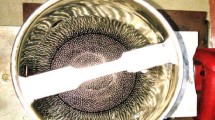This work presents the results of studies regarding the thermal stability of the surface layer of steel specimens subjected to combined hardening by electromechanical treatment (EMT) with subsequent surface plastic deformation (SPD), herein referred as (EMT + SPD). We also present the experimental data and characteristic aspects of the distribution of the microhardness of the white layer of steel samples 40H, 55, and 60S2A during sequential heating from 100°C to 400°C with an interval of T = 100°C. The results revealed that the thermal stability of surface-hardened EMT + SPD steel samples depends on the content of carbon and alloying elements of the original metal. Furthermore, the heat resistance of the white layer after EMT + SPD increased by 30–35% compared with the white layer obtained by traditional electromechanical processing and furnace martensite.
Similar content being viewed by others
Avoid common mistakes on your manuscript.
As a result of studies on the effects of electromechanical treatment (EMT) on the properties of metals under static and dynamic high-speed thermal deformation effects on the surface layer of metals [1,2,3], large amounts of experimental and theoretical materials were obtained regarding the use of a hardened surface layer (white layer) as a sort of “buffer” to protect the main metal. However, the experimental data on the thermal stability of white layers obtained in past works [1, 4,5,6] differ significantly. At present, aspects of the influence of high temperatures on the changes in mechanical properties of surface layers, especially those subjected to combined hardening by EMT and surface plastic deformation (SPD), now referred as EMT + SPD, are under-investigated. Such data are especially important for hardening parts designed to operate at elevated temperatures and pressures.
Therefore, the current work aimed to study the effects of elevated temperatures (tempering) on the strength properties of the surface layers of medium-carbon steels (of various chemical compositions) subjected to combined hardening by EMT with finishing SPD (EMT + SPD). The study objects were medium-carbon steel samples (grades 40H, 55, and 60S2A) in the normalized state after hardening with EMT + SPD. The compositions of the steel samples are presented in the Table 1.
During the studies, cylindrical steel samples with a diameter of 10 mm were subjected to surface hardening by EMT and subsequent SPD. Here, EMT represents high-temperature impact on a rotating sample by electric current (alternating sinusoidal current of industrial frequency 50 Hz; duration of one pulse 0.01 s; current density j = 400 A/mm2; voltage U = 4–5 V). The electric current was supplied to the sample surface through a hard-alloy roller with simultaneous force action P = 300 N, in which the value of the longitudinal feed of the hardening tool S was 2 mm/rev. As a result, regular helical tracks of hardened metal were formed on the surface of the cylindrical sample, which was a white layer (width a = 0.8 mm, maximum hardness Hμ = 10.5–11.0 GPa) featuring “interlayers” of unhardened base metal (hardness Hμ = 2.8–3.3 GPa). The feed mode was chosen by considering the exclusion of the mutual influence of the tracks.
The SPD of the samples after EMT was performed in a two-roller device with force P of 1.2 kN on the roller, feeding S of 0.25 mm/rev, spindle speed of 100 min-1, and n = 1 number of passes.
To study the thermal stability of the white surface layer, the samples were thermally treated (in a SNOL 7.2/1100 furnace) at temperatures T of 100°C, 200°C, 300°C, and 400°C with exposure for 1 h and subsequent cooling in air. In addition, we controlled the heat resistance of the surface layer after combined EMT + SPD hardening by changing the metal microhardness. Finally, we measured the microhardness by local volumes of the surface layer on a PMT-3 device using an indenter load of 1 N with a 30 μm distance between the indentations.
Figure 1 presents the results of a study of the distribution of microhardness along the axis of surface- hardened specimens of normalized steel grades 40H, 55, and 60S2A depending on the heat treatment (tempering) temperature. As can be seen, the structure of the white layers of steels of all grades in the initial state after EMT + SPD treatment was structureless martensite (alpha phase supersaturated with carbon) without an acicular structure. The microhardness of the hardened tracks on the steel samples of all grades was much higher than the base metal microhardness. Thus, compared to the initial microhardness values, the maximum microhardness of the hardened metal increased by 3.3, 3.7, and 3.0 times for the 40H, 55, and 60S2A steel samples, respectively.
The nature of the distribution of microhardness in the surface layer of the samples after heat treatment (tempering) indicated a significant effect of the heating temperature on the white layer microhardness. Upon analyzing the strength properties of the sample surfaces after heat treatment (T = 100°C), the results revealed the sufficient resistance of the white surface layer for steels of all grades (Figs. 1a–1c, curve 2). With an increase in temperature (T = 200°C), a slight decrease in hardness was revealed for steel grade 55 (Fig. 1b, curve 3), while the microhardness of steel grades 40H and 60S2A decreased by almost 30% (Figs. 1a and 1c, curve 3). A further increase in temperature (T = 400°C) led to a sharp decrease in the white layer microhardness; however, for steel grades 40H and 55, a decrease was noted to a lesser extent than for steel grade 60S2A, which remained at a rather high level ( Hμ = 6.0, 6.5, and 3.0–4.5 GPa for steel samples 40H, 55, and 60S2A, respectively.
When analyzing the distribution of microhardness on the surface of steel samples after heat treatment (T = 400°C), the results showed the significantly reduced inhomogeneity of microhardness in the tracks of the white layer of steels of all grades. Some exceptions were changes in the tracks of 60S2A steel, where local areas with the maximum value of microhardness in the tracks ( Hμ = 4.5 GPa) were revealed only at the interfaces between the hardened and nonhardened layers, while a significant decrease in hardness was noted in the tracks themselves ( Hμ = 3.5 GPa).
The aspects of the changes in the maximum and average values of the white layer microhardness depending on the tempering temperature during a 1 h exposure are presented in Fig. 2. When analyzing the curves (Fig. 2), the results revealed that the intensity of the white layer softening process was determined by the heating temperature of the samples. Furthermore, three stages of the white layer softening process were revealed. The decreases in maximum microhardness and average microhardness were insignificant at Stage 1 with a tempering of up to T of 100°C (Figs. 2a and 2b). A certain degree of decrease in the strength properties of the white layer was noted; however, the level of maximum hardness in the tracks was rather high withHμ of 8–10 GPa (Fig. 2a, curves 1–3).
Dependences of the maximum microhardness (a) and average microhardness (b) in the tracks of the white layer of steels hardened by electromechanical treatment + surface plastic deformation treatment on the heating temperature (with a treatment duration of 1 hour): 1 – steel 40H; 2 – steel 55; 3 – steel 60S2A.
The most intensive decreases in maximum microhardness and average microhardness occurred in the temperature range of 100–300°C (Stage 2: softening). If at T = 200°C for steel grade 55, the maximum microhardness Hμmax decreased by 1 GPa for 1 h (Fig. 2a, curve 2) than when the temperature increased to 300°C for the same period of time and decreased by 2.5 GPa. Therefore, the intensity of softening increased by 2.5 times.
The same nature of the course of softening was also noted for steel grades 40H and 60S2A. At temperatures above 300°C, the softening rate decreased, and the maximum microhardness remained at the Hμmax level of 6 GPa. In connection with the results obtained, the kinetics of the white layer softening process in the temperature range of 200–300°C was studied in more detail.
Figure 3 shows the changes in the maximum values of microhardness in the tracks of the white layer of steel samples hardened by electromechanical treatment + surface plastic deformation and at Stage 2 within the temperature range of 200–300°C. We analyzed the degree and intensity of the decreases in the maximum microhardness in the tracks of the white layer of samples with different values of carbon content and alloying elements. As shown in the figure, all the studied steels were characterized by the general regularities of a decrease in the maximum hardness as the heating temperature increased. However, the degree and intensity of the processes of reducing the microhardness depended on the steel composition. Thus, with an increased carbon content (in steel grades 55 and 60S2A), both the initial microhardness and heat resistance of the white layer increased by up to 300°C compared with steel grade 40H. At the same time, despite the rather high values of the maximum microhardness of 60S2A steel, areas with the maximum microhardness value in the tracks (Hμ = 7.8–8.2 GPa) were detected only at the boundaries of the white layer tracks with the nonhardened layers.
Histogram of the change in the maximum surface microhardness Hμmax in the tracks of the white layer of steels of various grades, hardened through combined electromechanical treatment + surface plastic deformation treatment in the elevated temperature range of 200–320°C: 1 – steel 40H; 2 – steel 55; 3 – steel 60S2A.
Furthermore, steel alloying with silicon in the amount of 1.6–2.0% led to the inhomogeneity of microhardness in the white layer tracks. In turn, this led to a significant decrease in the average microhardness of the white layer (about 50% for 60S2A steel, Fig. 2b, curve 3), which is 2.5 times higher than the intensity of the reduction in the hardness of steel samples of other grades. Thus, the following conclusions can be made:
-
The heat resistance of specimens made of carbon and alloy structural steels, which are surface- hardened by combined EMT + SPD treatment, depends on the carbon content in the steel (in the range of 0.4%–0.6%).
-
Alloying steel with 0.8–1.1% chromium only has a minimal effect on the heat resistance of the white layer.
-
When steel is alloyed with 1.6–2.0% silicon, the thermal resistance of the white layer decreases, despite local areas with maximum microhardness values at the interfaces between the hardened track and the nonhardened layer.
Thus, the softening intensity of the surface white layer of medium-carbon steel samples 40H, 55, and 60S2A, subjected to EMT + SPD treatment, depends on the heating temperature and the chemical composition of the steels at the initial state.
The work was supported by the Russian Science Foundation (Project No. 22-29-01078).
References
B. M. Askinazi, Hardening and Restoration of Machine Parts by Electromechanical Processing [in Russian], Mashinostroenie, Moscow (1989).
Yu. I. Babey, Physical Foundations of Impulse Hardening of Steel and Cast Iron [in Russian], Naukova Dumka, Kyiv (1988).
V. P. Bagmutov, S. N. Parshev, N. G. Dudkina, et al., Electromechanical Hardening of Metals and Alloys [in Russian], VolgGTU, Volgograd (2016).
K.V. Frolov (editor), Scientific and Technical Progress in Engineering [in Russian], IMASH AN SSSR, Moscow, Issue 9 (1989).
N. G. Dudkina, “Investigation of the effect of tempering temperature on the microhardness of the surface layer of steel 45 subjected to shock electromechanical processing,” Khimi. Neftegaz. Mashinostr., No. 12, 35–37 (2020).
N. G. Dudkina, “Study of the heat resistance of the surface layer of steel 45 subjected to electromechanical hardening,” Problemy Mashinostr. Nadezhn. Mashin, No. 2, 75–77 (2008).
Author information
Authors and Affiliations
Corresponding author
Additional information
Translated from Khimicheskoe i Neftegazovoe Mashinostroenie, Vol. 59, No. 3, pp. 42−45, March, 2023.
Rights and permissions
Springer Nature or its licensor (e.g. a society or other partner) holds exclusive rights to this article under a publishing agreement with the author(s) or other rightsholder(s); author self-archiving of the accepted manuscript version of this article is solely governed by the terms of such publishing agreement and applicable law.
About this article
Cite this article
Dudkina, N.G., Zakharov, I.N. & Barinov, V.V. Influence of the Chemical Composition of Steel on the Heat Resistance of a Surface Layer Subjected to Combined Hardening Treatment with Electromechanical Treatment + Surface Plastic Deformation. Chem Petrol Eng 59, 253–258 (2023). https://doi.org/10.1007/s10556-023-01236-y
Published:
Issue Date:
DOI: https://doi.org/10.1007/s10556-023-01236-y







